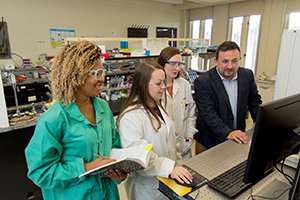Forensic chemist uses sweat to distinguish individuals at crime scene

An average square inch of skin contains 650 sweat glands. That means our bodies leave small amounts of sweat on everything we touch—whether we're making a phone call, eating supper or committing a crime.
Jan Halámek believes investigators can use these tiny, often invisible skin secretions to their advantage.
Halámek, an assistant professor of Chemistry at the University at Albany, has released a new paper in Analytical Chemistry, which proposes analyzing sweat left behind at a crime scene to determine the number of people who were there. The analysis can be used on site at the scene and offer immediate results.
"We are looking at two concepts in this paper. First, that each of our skin secretions are different and, therefore, unique to us. Like a fingerprint. Also, we are continuously secreting sweat throughout the day that is being deposited in small amounts as we travel and touch various objects," Halámek said. "By combining these concepts, we were able to show that, statistically, sweat left behind at a crime scene can help forensic investigators."
Skin secretions contain a large number of amino acids and metabolites that Halámek says can be targeted once detected on a surface.
His team measures the levels of three of those metabolites—lactate, urea and glutamate. Lactate appears in high concentrations of our sweat and varies greatly based on a person's lifestyle. Urea and glutamate, also highly concentrated, are found in different parts of our sweat. The chances of two people having the same levels of all three metabolites is virtually zero.
To test their analysis, Halámek's team created 25 mimicked sweat samples and took another 25 authentic sweat samples from the forearms of volunteers. Their results indicated that all 50 samples were easily distinguishable.
The next step is to test real crime scene samples.
"Investigators tend to overlook the presence of sweat at crime scenes. Our paper is proving it has value," Halámek said. "Without sufficient DNA evidence, which can take days or weeks of analysis, it can be difficult to determine how many people were present at a crime scene. We can quickly gather that information."
Halámek said his analysis currently is unable to match the sweat samples with individuals. This is because metabolites are known to fluctuate over time due to lifestyle changes. For example, some metabolite levels vary with exercise or diet, while others might when a person is sick. However, his lab is beginning to monitor patterns in fluctuations, with a long-term goal of creating a "sweat profile" database.
The paper's first author was UAlbany graduate student Mindy Hair; other student co-authors include senior Adrianna Mathis and graduate student Erica Brunelle. The National Institute of Justice funded the research.
Halámek's new paper adds to a growing portfolio of research that involves non-invasive testing of biomarkers—blood and sweat—to catch criminals.
His team also developed a sweat-based authentication approach for unlocking mobile and wearable devices.
More information: Mindy E. Hair et al. Metabolite Biometrics for the Differentiation of Individuals, Analytical Chemistry (2018). DOI: 10.1021/acs.analchem.8b00414
Journal information: Analytical Chemistry
Provided by University at Albany




















